With their vivid golden yellow, daisy-like blooms, the black-eyed Susan plants (Rudbeckia hirta) will surely add a splash of colors in your garden.
Black-eyed Susan is one of the most sought-after short-lived perennial flowers grown today. Though sometimes considered an abundant wildflower or grown as annuals or biennials, these plants are a favorite of many gardeners and flower enthusiasts, especially in hot and sunny areas. Not only are they attractive, but also easy to grow.
In this guide, we collated and summarized the essentials of this beautiful flowering plant.
Plant Name and Origin

The name black-eyed Susan is an epithet of the flower’s signature dark brown center, hence the “black-eyed” reference.
Nevertheless, who was Susan? The legend says that the name black-eyed Susan originated from an Old English Poem written by John Gay entitled ‘Sweet William’s Farewell To Black-Eyed Susan’. The poem was about how these wildflowers and the sweet William plant (Dianthus barbatus) bloom together beautifully.
The Botanical Name
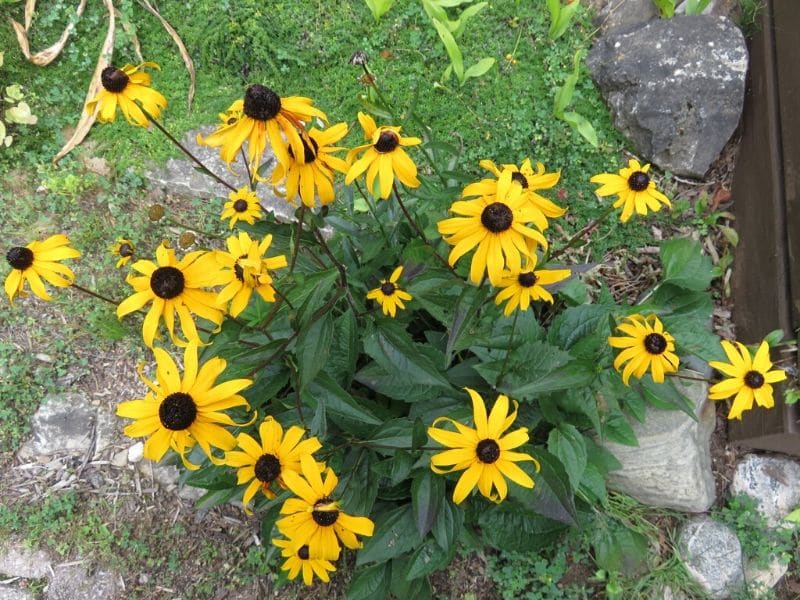
Black-eyed Susan is the common name for the entire genus of Rudbeckia (Rudbeckia spp.). Although it often refers explicitly to the Rudbeckia hirta species.
Botanist Carolus Linnaeus gave the genus name Rudbeckia as a nod to the renowned Swedish father and son duo, both named Olof Rudbeck. The older Rudbeck was a professor of medicine at Uppsala University and a scientist recognized for his works in the field of human anatomy and linguistics. Olof Rudbeck the Younger, his son, is a distinguished botanist like Linnaeus.
The species name hirta, on the other hand, comes from the Latin word “hirtus.” It translates to “hairy,” describing the plant’s leaves, stems, and phyllaries (1).
Other Popular Common Names
The plant Rudbeckia hirta is commonly known as the black-eyed Susan. Other known names of this attractive plant include coneflower and gloriosa daisy (2). It is sometimes called brown-eyed Susan, brown betty, poor-land daisy, golden Jerusalem, yellow daisy, yellow ox-eye daisy, and English bull’s eye.
Black-eyed Susan is also written black-eyed Susan or blackeyed Susan.
Black-Eyed Susan vs Black-Eyed Susan Vine
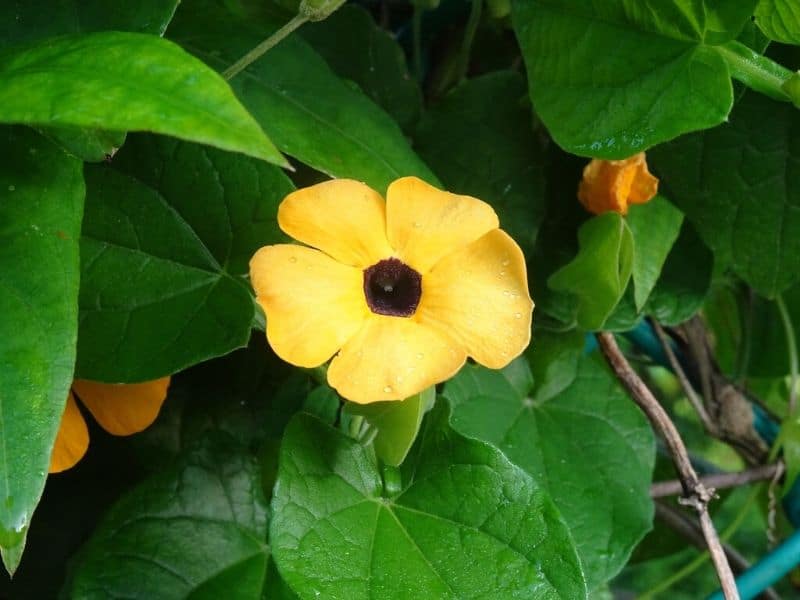
Another plant that shares the black-eyed Susan common name is the Thunbergia alata, or more commonly referred to as the black-eyed Susan vine.
Unlike the Rudbeckia black-eyed Susan, the Thunbergia black-eyed Susan vine has tubular blooms with five broad, clear-colored, and overlapping petals. At the center of these petals is a dark, brownish tube.
The central portion of Rudbeckia flowers, on the other hand, are flower heads comprised of numerous disk florets – which are noticeably lacking from the vined black-eyed Susans.
Plant History
Long before its prevalence as an ornamental, the black-eyed Susan plant is already highly valued for its medicinal properties.
Reports note that the pre-colonial Native American tribes like the Ojibwa, Chippewa, Menominee, and Potawatomi tribes utilize black-eyed Susans as herbal medicine. They used this plant as an external wash against snake bites.
Moreover, they use the infusion of the plant as a treatment for colds and worms, and the root sap for earaches (3).
Plant Description and Facts
Rudbeckia hirta is a prolific flowering plant that can be an annual, biennial, or a short-lived perennial. Mature plants typically reach up to 3.3 ft high with branched stems and an erect form.
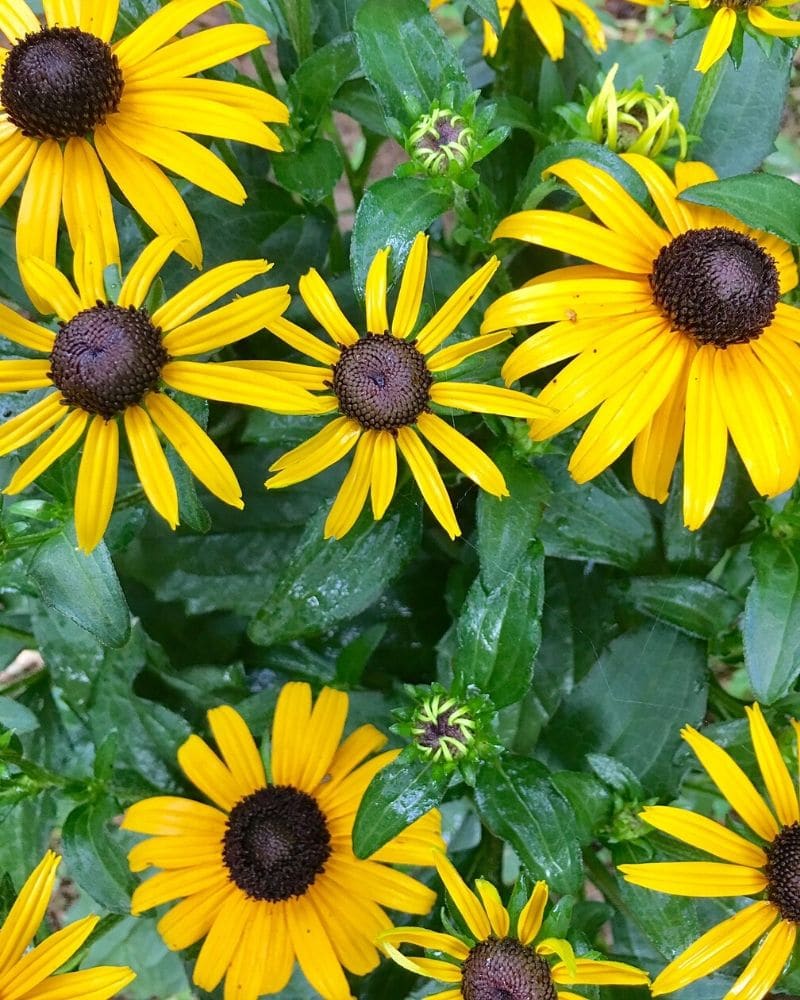
Leaves
The deciduous leaves are hairy and lanceolate to ovate, measuring about 5 to 17.5 cm long. The leaves at the lower portion of the plant are more substantial and thin out into long stalks. Leaf texture is rough.
Flowers
This plant’s bright flowers flourish in the summer with diverse colors depending on the variety. Though the majority of black-eyed Susans exhibit eye-catching golden yellow flowers, other types have orange, red, or burgundy hues (4).
Black-eyed Susan flowers are borne singly or in corymb with hairy phyllaries. Each flower has 8 to 16 florets that are 15 to 45 mm in length and 5 to 10 mm in width. The central disk florets are typically brown (though other cultivars display green disk florets) and measure about 12 to 22 cm in diameter (1).
Seeds
The seeds are small, about 1/16 inches long, brown/copper in color, and without plume (5). They are four-sided achenes and elliptical.
Black-Eyed Susan Varieties and Cultivars

Recognized Varieties
Rudbeckia hirta plants are native to North America. They are part of the Asteraceae or sunflower family with four recognized varieties, such as the Rudbeckia hirta var. angustifolia, Rudbeckia hirta var. floridana, Rudbeckia hirta var. hirta, and Rudbeckia hirta var. pulcherrima. Each of these varieties is associated with different geographic regions of North America.
Rudbeckia hirta var. angustifolia
Also known as the coastal plain black-eyed Susans, Rudbeckia hirta var. angustifolia is a native wildflower from Texas and the southeastern part of the United States of America to North Carolina. They are ubiquitous in fields, meadows, and roadsides.
This single-stemmed variety of black-eyed Susans grow up to 3.3 ft in height.
Rudbeckia hirta var. floridana
As the name suggests, this variety of Rudbeckia hirta grows in central to southern parts of Florida. Like other black-eyed Susans, they can be annuals, biennials, or perennials with blooms commencing from spring to fall. Stems are branched and leafy toward bases. They frequent roadsides, old fields, and pastures.
Rudbeckia hirta var. hirta
The Rudbeckia hirta var. hirta variety, or commonly known as the woodland black-eyed Susan, is found in the eastern United States of America. These plants grow in clearings, roadsides, and open woods.
Rudbeckia hirta var. pulcherrima
The Rudbeckia hirta var. pulcherrima often grow in places where the soil has been disturbed, such as roadsides or old fields (6). Among the four varieties of R. hirta, this is the most widespread. It can be seen in southern Canada and all the continental US with Nevada and Arizona as exemptions (7).
Popular Black-Eyed Susan Cultivars
Because of the popularity and adaptability of black-eyed Susans, plant breeders have developed countless cultivars or cultivated varieties of the plant. The following are some of the top cultivars of this summer-favorite plant.
Rudbeckia hirta ‘Indian Summer’
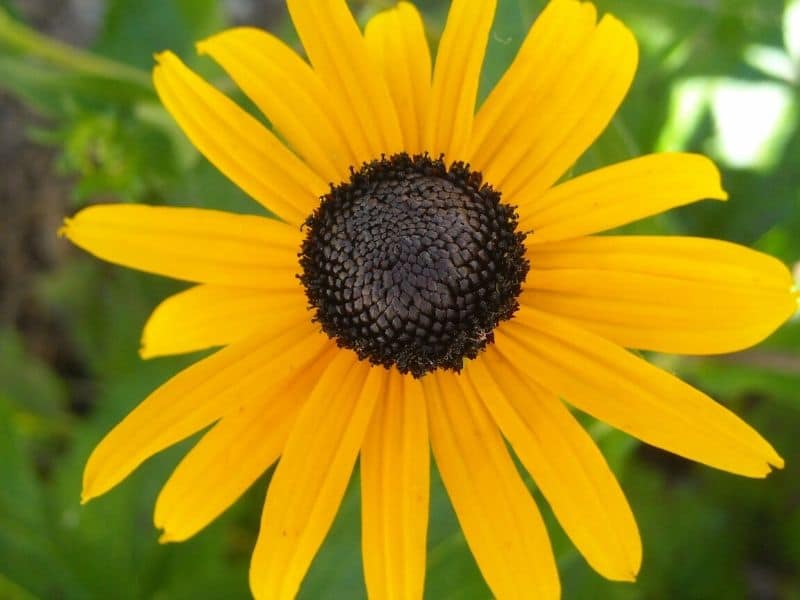
‘Indian Summer’ is probably the most popular cultivar of black-eyed Susan ever since it got the Award of Garden Merit recognition from the Royal Horticultural Society.
Frequently used in commercial garden landscapes, this short-lived perennial flaunts huge golden-yellow flowers with dark brown centers. The flowers bloom in the first year.
Rudbeckia hirta ‘Prairie Sun’
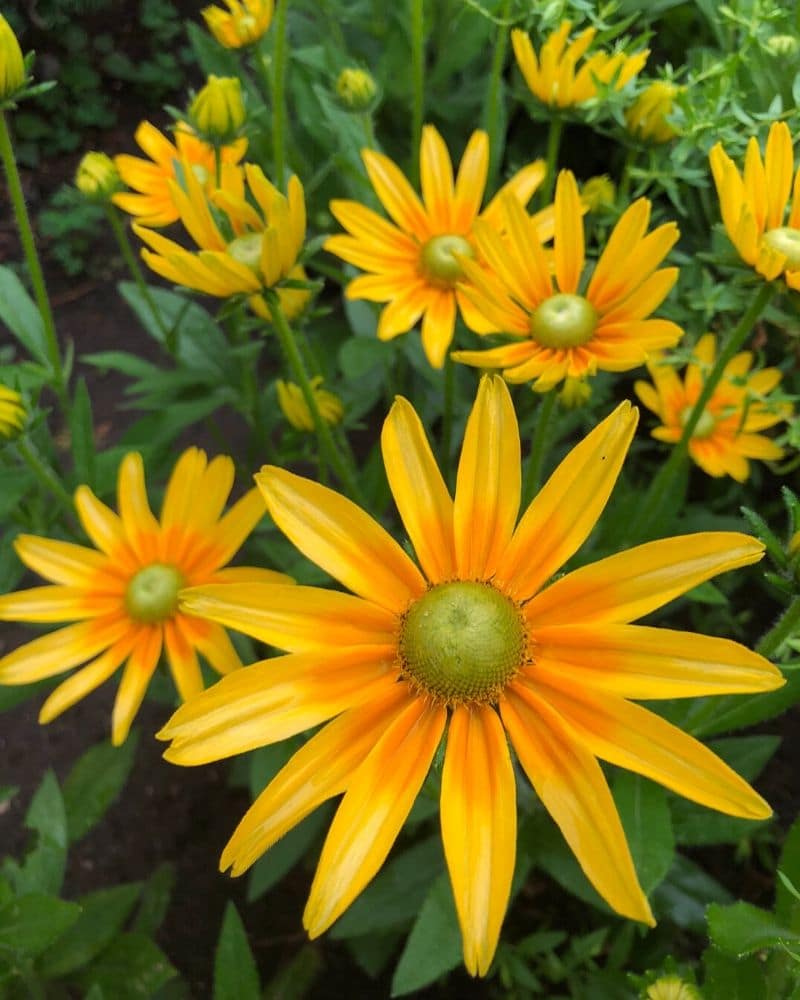
Unlike the more common black-eyed Susans, the ‘Prairie Sun’ cultivars lack the usual dark brown center. Instead, they have a light green, button-like disk florets surrounded by large gold ray petals (8).
Ideal as cut flowers, the ‘Prairie Sun’ cultivars have long and sturdy branching stems and bloom from mid-summer to fall. The plants grow to 27 to 31 inches tall and spread up to 16 inches.
Rudbeckia hirta ‘Toto’
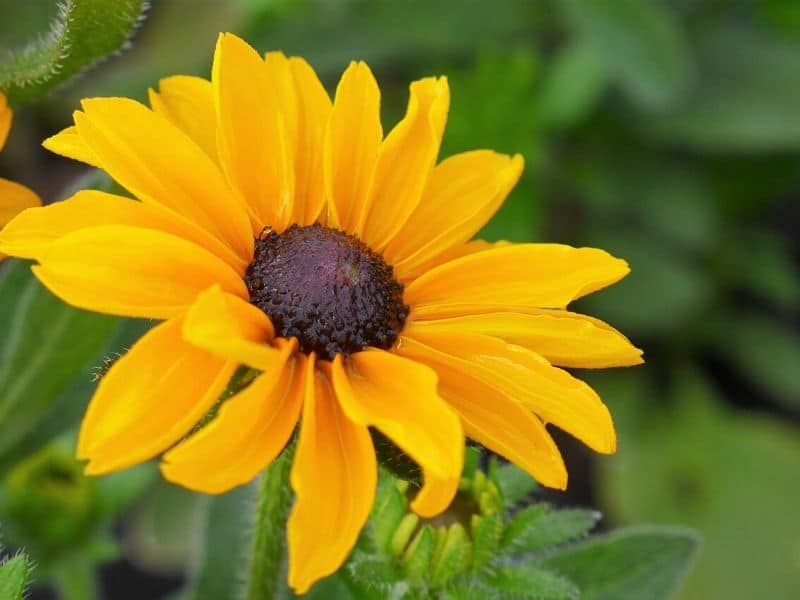
The Rudbeckia hirta ‘Toto’ is a dwarf cultivar of black-eyed Susans, growing about 12 to 16 inches in height and spreading up to 10 to 12 inches (9).
It is often used as plant accents or for mixed borders, container gardening, or cutting gardens. The flowers are large, with golden yellow petals and dark brown centers.
Rudbeckia hirta ‘Rustic Colors’
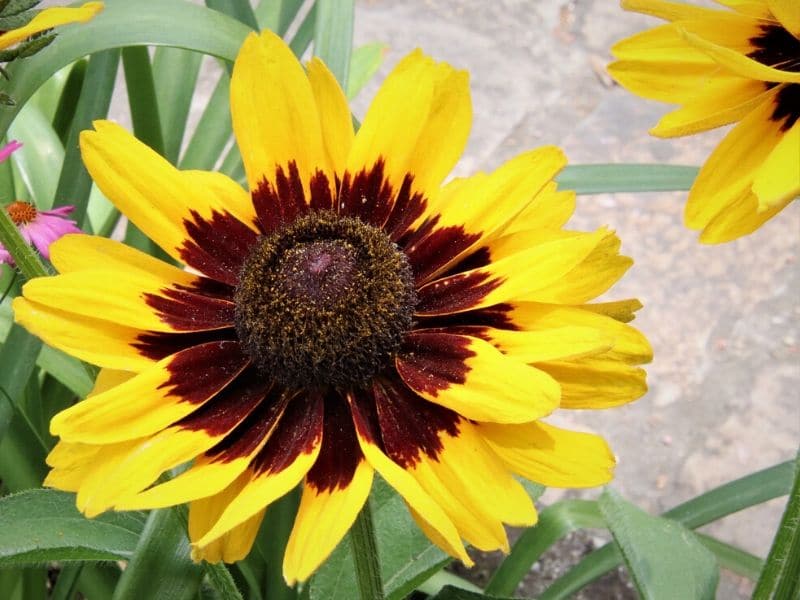
This cultivar is not like any average black-eyed Susan. The large daisy-like flowers bear petals that range from yellow to mahogany, orange, and red.
These flowers, which are ideal as cut flowers for bouquets, bloom all summer. The plant grows up to 18 to 24 inches tall and spreads up to 18 inches.
Rudbeckia hirta ‘Autumn Colors’
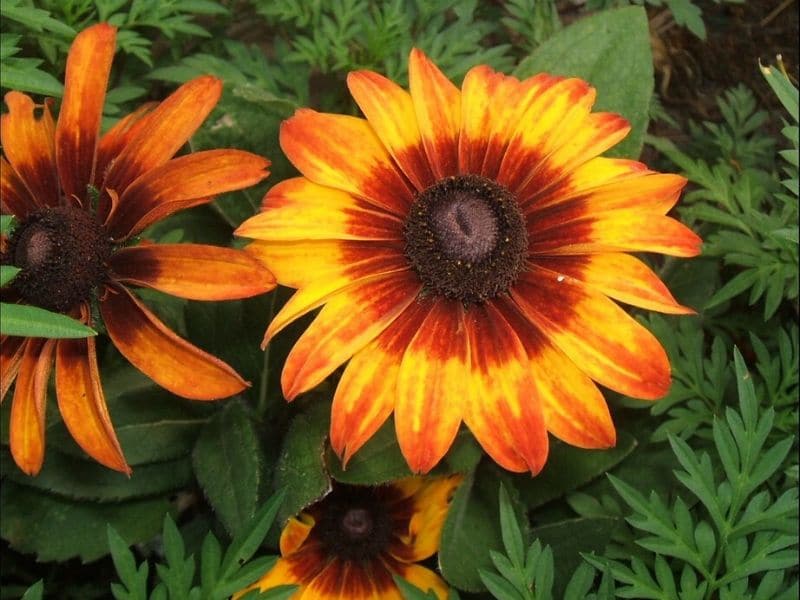
The ‘Autumn Colors’ cultivar of black-eyed Susan produces abundant golden flowers with hints of gradient-like red, bronze, or rust towards the center. The plant grows upright up to 18 to 24 inches and spreads about 18 inches. Because of its performance and good looks, it gained the Fleuroselect Quality Mark award.
Other well-received R. hirta cultivars are the following:
- Rudbeckia hirta ‘Marmalade’
- Rudbeckia hirta ‘Cherokee Sunset’
- Rudbeckia hirta ‘Denver Daisy’
- Rudbeckia hirta ‘Sonora’
Growing Black-Eyed Susans
These summer-favorite flowers sure fill flower beds with their gorgeous colors. However, to maximize their beauty, basic knowledge of proper care and maintenance of black-eyed Susans should be enough to help anyone in growing them.
How to Plant Black-Eyed Susans
There are two ways to include black-eyed Susans in a garden. You can grow them from seeds (by direct sowing or transplanting), or you can buy established plants from nurseries or garden centers and transplant them in your yard.
When do you plant black-eyed Susan seeds? The best time is to do the seed sowing before the last frost. Seed germinates within 8-14 days at 68-72°F (20-22°C).
It is crucial to keep young black-eyed Susan plants well-watered until they become fully established so they will not dry out. Once established, the plants only need deep watering at least once a week.
These plants grow quickly and start blooming at an early age. They tend to spread out, so allow 12″ to 18″ planting space in between plants.
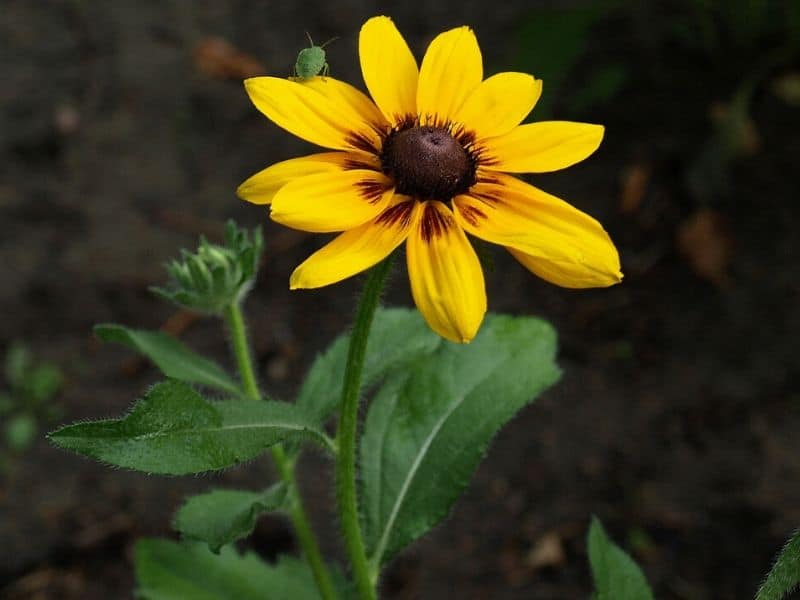
Black eyed Susan Care and Maintenance
Like other plants in the Asteraceae family, black-eyed Susans prefer full sun with six or more hours of direct sunlight a day, though they can handle partial shade as well.
These plants adapt well in different soil textures, including clay, loam, or sand, as long as the soil is well-drained, moist, and occasionally dry. Drought tolerance is high, while salt tolerance is good (2). The use of fertilizer is not necessary since too much of it will make the plant weak.
Regular deadheading of faded flowers will keep black-eyed Susans bloom more profusely. These plants do not require pruning, but you can do pinching by cutting back just the growing tip of the plant to encourage a prolonged blooming period.
Pests and Diseases
Black-eyed Susans are moderately resistant to deers once fully established. They are, however, susceptible to aphids.
The most common disease of these plants is powdery mildew, which occurs when the plants are frequently subjected to humid conditions. Affected plants show yellowing and falling off of leaves caused by white fungal growth. Avoid this by planting Rudbeckias in full sun with good air circulation.
Other identified diseases of these plants include aster yellows, bacterial leaf spots, fungal leaf spots, rusts, stem rot, verticillium wilt, septoria leaf spot, and viruses (10).
Meaning and Symbolism
The black eyed Susan has been Maryland’s official state flower since its designation on April 18, 1918. What does the black eyed Susan symbolize?
Black-eyed Susan symbolism includes encouragement and motivation, which can be attributed to the plant’s adaptability and widespread availability.
FAQs
Should I cut back black-eyed Susans in fall?
It’s generally recommended to leave the foliage of black-eyed Susans (Rudbeckia) standing in the fall. The seed heads can provide food for birds, and the dried plant material helps protect the roots during winter.
How long do black-eyed Susans last?
Black-eyed Susans are typically perennial plants, and with proper care, they can last for many years, blooming from midsummer to fall.
Why are my black-eyed Susans dying?
Black-eyed Susans may be dying due to issues such as overwatering, poor soil drainage, or diseases. Assess the growing conditions, adjust watering practices, and address any potential diseases to improve plant health.
What to do with black-eyed Susans after they bloom?
After black-eyed Susans bloom, deadhead spent flowers regularly to encourage continuous blooming. In late fall or early spring, you can cut back the dead foliage to the ground to make way for new growth in the next season.
Do you like a splash of cheerful yellow flowers in your garden? If you find black-eyed Susans fascinating, then this guide is one way to help you get started. Share your thoughts in the comment section below!
Also, check out our article on perennial plants and flowers for more information about flowers similar to black-eyed Susans.
Up Next:
References
Reference list
(1) Labunix.uqam.ca. (2019). Rudbeckia hirta Linnaeus. [online] Available at: https://www.labunix.uqam.ca/~fg/MyFlora/Asteraceae/Rudbeckia/Hirta/hirta.e.shtml
(2) Gilman, E. and Howe, T. (2019). Rudbeckia hirta Black-Eyed Susan, Gloriosa Daisy. [online] University of Florida IFAS Extension. Available at: https://edis.ifas.ufl.edu/pdffiles/FP/FP51200.pdf
(3) Webstu.onu.edu. (2019). Rudbeckia Hirta | The Medicinal Herb Gardens at ONU. [online] Available at: https://webstu.onu.edu/garden/node/57
(4) Plants.ces.ncsu.edu. (2019). Rudbeckia hirta (Black-eyed Susan, Gloriosa Daisy) | North Carolina Extension Gardener Plant Toolbox. [online] Available at: https://plants.ces.ncsu.edu/plants/rudbeckia-hirta/
(5) Uipress.lib.uiowa.edu. (2019). Prairie Plants of Iowa – Rudbeckia hirta L.. [online] Available at: http://uipress.lib.uiowa.edu/ppi/display.php?record=Rudbeckia_hirta
(6) Extension.umd.edu. (2019). Black-Eyed Susan | University of Maryland Extension. [online] Available at: https://extension.umd.edu/hgic/topics/black-eyed-susan
(7) Nrcs.usda.gov. (2019). [online] Available at: https://www.nrcs.usda.gov/Internet/FSE_PLANTMATERIALS/publications/etpmcpg13467.pdf
(8) Cutflowers.ces.ncsu.edu. (2019). Rudbeckia Hirta ‘Prairie Sun’. [online] Available at: https://cutflowers.ces.ncsu.edu/rudbeckia-hirta-prairie-sun/
(9) Jeffers, A. (1999). Rudbeckia. [online] Home & Garden Information Center | Clemson University, South Carolina. Available at: https://hgic.clemson.edu/factsheet/rudbeckia/
(10) Penn State Extension. (2019). Rudbeckia Diseases. [online] Available at: https://extension.psu.edu/rudbeckia-diseases
Images via Pixabay
Close






